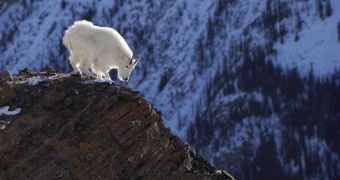Together with the bighorn sheep, the mountain goat (Oreamnos americanus) is one of the symbols of the Rocky Mountains, inhabiting their rough and barren cliffs and executing amazing stunts amongst the rocks. Today, no more than 5,000 mountain goats are found, about 1,500-2,000 being encountered in the Glacier National Park (Montana) and Olympic Mountains (Washington), places in which they were transferred and quickly adapted.
These animals are the only non-polar species whose coat is white during both the winter and summer.
Despite the name "goat", this is a true mountain antelope, closer related to the European chamois (Rupricapra) and gorals and serows (Nemarhoedus) of eastern/southern Asia than to the real goats (Capra). This group of antelopes emerged during the Pliocene (2-5 million years ago) in Central Asia and the mountain goat entered North America several tens of thousands of years ago, during the upper Pleistocene, through the Behring Land Bridge, the same place through which the bighorn, bison, gray wolf and grizzly bear entered North America (and the horse went from North America to Eurasia).
The mountain goat is 91-107 cm (3-3.5 ft) tall and weighs 45-135 kg (100-300 pounds). The sharp blackish horns are up to 29 cm (0.95 ft) long. The animal has 32 teeth, and unlike true goats, it possesses 4 teats.
The animal prefers alpine pastures above the forest area and stay close to steep slopes where it can find refuge easily. It is diurnal and lives in groups of 10-15 individuals and feeds on both grass and bushes. The animals rarely move more than 3-5 km (1.8-3 mi) daily, but, during the winter, they may descend to lower altitudes.
Sexual maturity is reached by the age of 2, and the female gives birth to 1-2 (rarely 3) kids in May-June. In the wild, the mountain goats live 10-12 years, but in captivity, much longer. The animals defend themselves using their horns against wolves, stray dogs, eagles and sometimes even bears.
Males combat using their horns during the mating season, in October-November, but their resistant and elastic skin attenuates the effect of the shock caused by the sharp horns. The skin was once used by Amerindians, due to its qualities, for making war shields. The non-receptive females are extremely aggressive with the males.
Mountain goats do not usually defend a territory of their own but, during the mating season, the males chase away any male competitor. The adversaries are warned by the local alpha male through scent marks represented by urine (whose smell is extremely powerful). The male smear their flanks with urine, which at the same time attracts the females.

 14 DAY TRIAL //
14 DAY TRIAL //